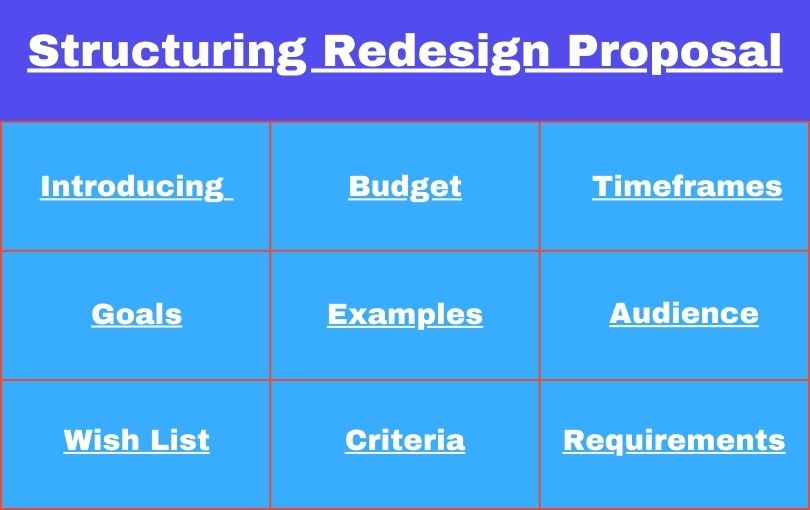For most business owners, venturing into the digital realm is a massive undertaking. From establishing a thriving social presence and setting up paid campaigns to web and app development, the huge surge of information and touchpoints can overwhelm even the most prepared entrepreneur.
Website redesigns can be a challenge as well. And often, apart from determining the new concept, entrepreneurs also have to shortlist the candidates with whom they will partner. So, how do you shortlist your potential candidates? The fastest way is to create a comprehensive website redesign proposal.
As such, in this article, we’ll talk about the essentials of writing a website redesign request for proposal, or RFP.
What Is A Website Redesign Proposal?
A website design request for proposal is a document that you create to outline your new site’s unique requirements, project goals, budget, scope, and timeline. It’s a blueprint that will help you find the right agency to partner with. RFPs can provide your needs in detail and as such, they can be used to select the best vendor based on their feedback after receiving the proposal.
Apart from website redesign, you can create proposals for:
- Digital Marketing
- Web Development
- SEO
- IT Services
- Software Development
- Mobile App Development
- eCommerce Development
- Social Media
- Branding
Why Is a Website Redesign Proposal Important?
As you might have already guessed, a web redesign proposal helps you to reach several agencies at the same time and lets you review and better compare vendor submissions before you opt for an agency. In short, an RFP enables you to find the best match for your redesign project.
Such proposals can become invaluable when you need to find a reliable partner that provides more intricate website redesign services. In other words, RFPs come into play when your project has a wider scope, addressing possibly your branding, your site’s UX/UI, features, and more foundational elements, such as overhauling or changing your backend. When such complex work is involved, a proposal can help you highlight your needs, while also enabling you to see how potential vendors would tackle these same intricate issues.
Website Redesign vs. Website Design Proposals
Before getting into more detail, we should address the differences between these two terms to avoid any confusion down the road. A website design RFP is a document that specifies the goals and requirements of your brand’s website. A redesign proposal, on the other hand, highlights the existing challenges your website faces and also discusses which elements should be changed and to what extent (in most cases).
In the latter case, areas of improvement may include your site’s navigation, visuals, functionality, structure, or even content.
Sending Out Your Redesign Proposal to Agencies
Before addressing your redesign strategy, here are a few useful tips on how you should search for agencies with your RFP. You can look for possible vendors for your redesign in several ways.
Publish The Proposal on Your Site
You can simply publish the RFP on your site or build a landing page for it. The proposal should include every project-related detail and can serve as a reference page for potential agencies. For the best results, create a downloadable version of your proposal.
Use Dedicated Portals
Another great way is to use specific sites, such as the RFP Database which allows you to display your redesign projects to different potential agencies. Simply create an account, upload the document, and fill out a short form and you are good to go.
Search on Google
Even the search results can help you shortlist potential candidates. Chances are, the agencies that appear highest on the SERPs (search engine results pages) are knowledgeable about search engine optimization, or SEO. Chances are as well, optimization will be a crucial factor in your redesign project, so finding an agency that also excels in SEO can kill two birds with one stone.
Recommendations
You can also ask fellow entrepreneurs about how they tackled their web design or redesign needs. Look for designs that you are particularly fond of, and reach out to those site owners so you can discuss their experiences. Shortlist the agencies based on positive feedback, and reach out to them to bid on your redesign project.
Structuring Your Redesign Proposal
How do you structure your RFP? Think about it as a checklist that discusses the scope of the work, your budget, expected timeline, goals, inspirational sources, vendor criteria, and more.

Introducing Your Company
You should start the proposal by briefly introducing your brand. Describe what your brand is about, including your vision, mission, products, and tone of voice. This section should also briefly outline what the project will cover.
Stating Your Budget
Highlighting the amount of resources you are willing to allocate to the redesign project is also crucial as it will allow agencies to see whether they can provide the desired scope of work within your budget.
The cost of the redesign will depend on several factors, but most importantly, it will be determined by at least three agency-related factors. These are team member expertise, the agency’s hourly rate, and whether you will choose a template or custom approach.
If you have no idea where to start with estimating your budget, you can find valuable information on online forums, blogs, and even in client reviews to get a better understanding of your redesign costs.
Specifying Deadlines and Timeframes
Next stop, you should provide realistic expectations regarding different timeframes for deliverables and site launch of your project. This allows agencies to determine whether they can take on the project and finish it by the highlighted deadline.
The timeframe should set clear tasks and deliverable completion deadlines, keeping everybody who’s involved in the project on the same page. Ensure that you also establish your reviewing, revision, and approval timeframes, to avoid project delays.
Deadlines to consider:
- Date of Releasing the RFP: First, vendors need to know just how recent your request is.
- Response Deadline: Notify agencies about the date you expect to get your proposal responses.
- Vendor Selection Date: This deadline shows when agencies should expect your reply about your decision.
- Project Start: This highlights when you want to get started working on the redesign project.
- Deliverable Timeline: An estimated timeframe that you’d want to delegate to discuss, receive, review, and approve design elements or other deliverables (such as new content or visuals)
- Desired Launch Date: As the name implies, this should feature a realistic date that would mark the launch of your redesigned website.
Defining Your Goals
No matter whether you want to improve your branding, or create better user experiences, you should also highlight what goals you want to achieve with the redesign. On that note, your goals might be improved lead generation, better online presence, brand awareness, or more effective engagement with potential and existing clientele.
Providing Inspiration and Examples
You will be discussing the structural and visual details with the agency later on. However, it also helps a lot if you provide at least a few examples of other sites so the experts can get a better idea of what you’d like your redesign to look like.
Create a short list of around five websites you like, and highlight whether you find the visuals, functionality, or other elements engaging and intriguing.
Talking About Target Audience
Your redesigned website should address the needs and preferences of your target audience to boost your engagement rates and conversions. As such, you should clarify who your target audience is so your vendors know how to get started with the project.
To help their work, consider adding general target audience demographics to your proposal along with user personas.
Creating a Redesign Wish List
You should also consider creating a list of must-have redesign features and “nice to have features” which you’d also like to implement if the timeframe and budget allows it. Such things might include:
- Branded typography and visuals
- Visible contact details
- SEO strategies
- Client testimonials and other social proof
- Revamped and optimized content
- Sticky navigation
Setting Up Agency Criteria
In this section, you should explain to the agencies how you will select your preferred vendor. Criteria might be agency expertise, portfolio, relevant project, service scope, experience, and more.
This will help weed out agencies that don’t match your standards, speeding up the redesign process.
Highlighting Submission Requirements
Lastly, outline all the requirements you expect from the agencies who respond to your proposal. The outline should detail how they are supposed to send their responses (like via email).
Typically, site owners will request the following information:
- Agency name, address, email, website, and other contact details.
- Years of experience, certifications, awards, and team expertise
- The approximate project timeline from start to finish
- Client references and similar projects
- Redesign case studies
Finishing Thoughts on Website Redesign Proposals
Trying to come up with a proposal might seem like a daunting and overwhelming task, however, being as meticulous as possible is the best way to find the best agency for the job. A well-rounded proposal can help you understand your own redesign needs and lay down the foundation of a more structured project that you can spearhead with the right agency, that also has the know-how, experience, and tools to take care of the task from start to finish.
A website design RFP outlines the important details of your project so you can find a qualified agency that’s the perfect fit for your website design.
To recap, your website design RFP should include your:
- Company background
- Budget range
- Project timeframe and deadlines
- Website goals
- Website examples and inspiration
- Target audience
- Website must-haves
- Criteria for vendor selection
- Submission requirements
Once your detailed RFP is created, it’s time to send it out!
Position it as a downloadable file on your website, showcase it on the RFP database, search for agencies on Google, or ask around for recommendations.
Once the submissions are in, weed through the responses, shortlist several agencies, conduct interviews, and partner with the best agency for the job.





